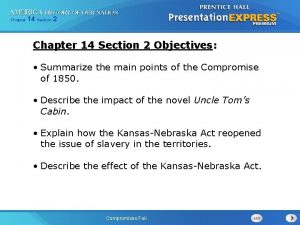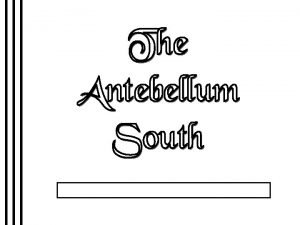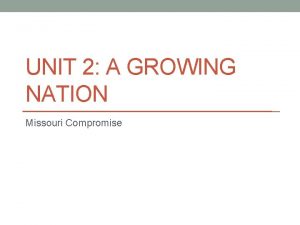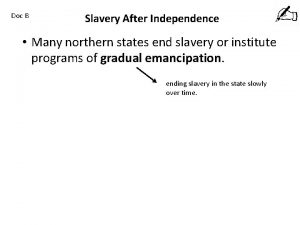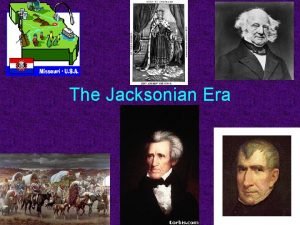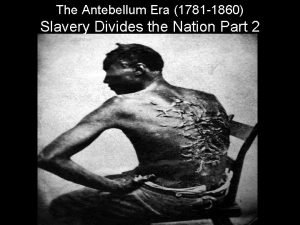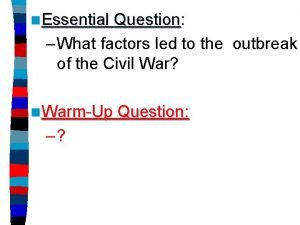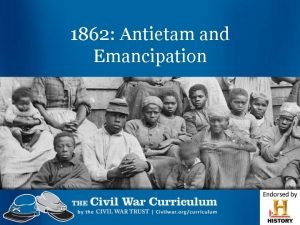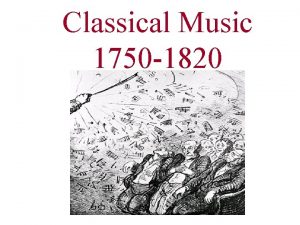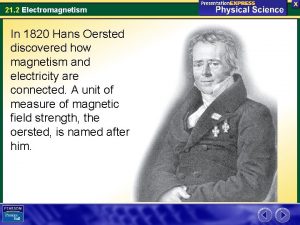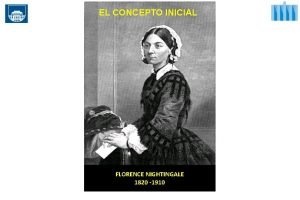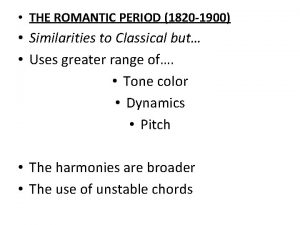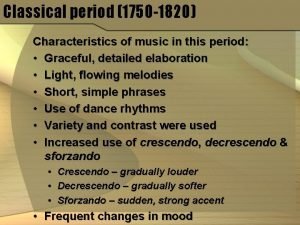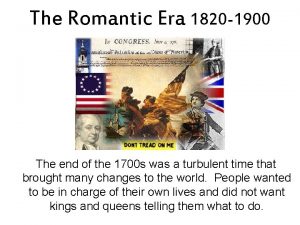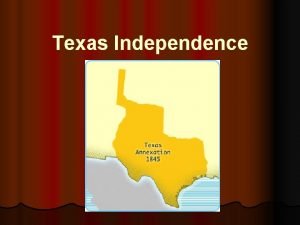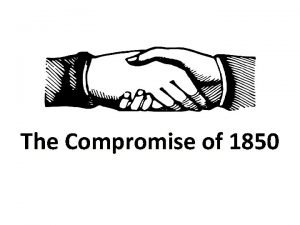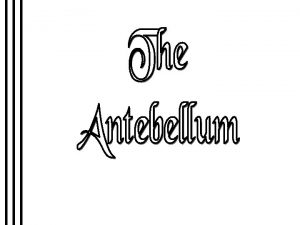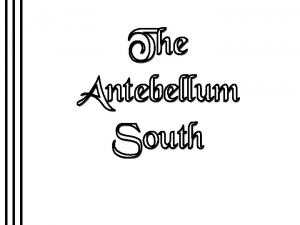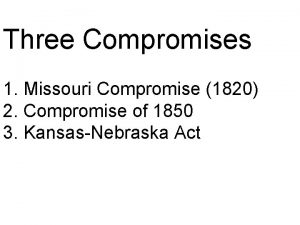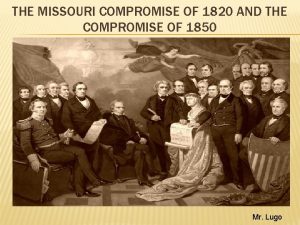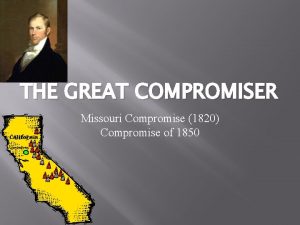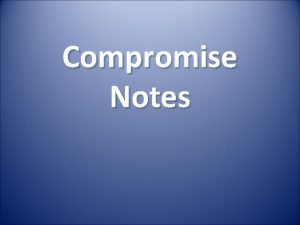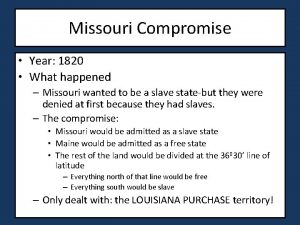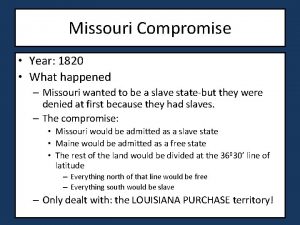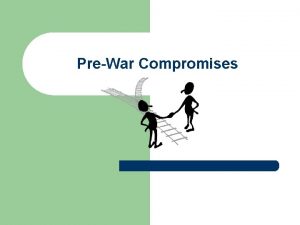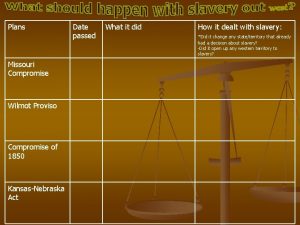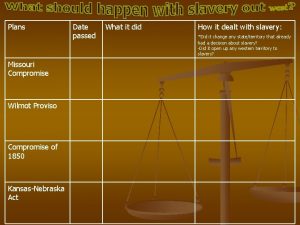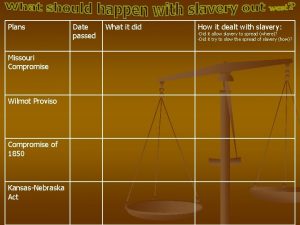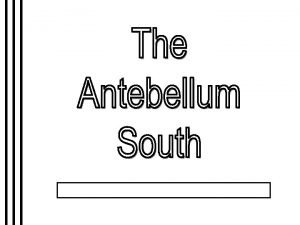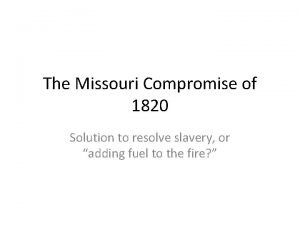Early Emancipation in the North Missouri Compromise 1820





![Southern Society (1850) 25% “Slavocracy” [plantation owners] 20+ (12%) Small slaveowner –less than 20 Southern Society (1850) 25% “Slavocracy” [plantation owners] 20+ (12%) Small slaveowner –less than 20](https://slidetodoc.com/presentation_image_h2/0ec43c12a7668ff4a4ef4b0c3b040306/image-6.jpg)





































![The Culture of Slavery 1. Black Christianity [Baptists or Methodists]: * more emotional worship The Culture of Slavery 1. Black Christianity [Baptists or Methodists]: * more emotional worship](https://slidetodoc.com/presentation_image_h2/0ec43c12a7668ff4a4ef4b0c3b040306/image-44.jpg)
- Slides: 44


Early Emancipation in the North

Missouri Compromise, 1820


Characteristics of the Antebellum South 1. Primarily agrarian. 2. Economic power shifted from the “upper South” to the “lower South. ” 3. “Cotton Is King!” * 1860 5 mil. bales a yr. (57% of total US exports). 4. Very slow development of industrialization. 5. Inadequate transportation system.
![Southern Society 1850 25 Slavocracy plantation owners 20 12 Small slaveowner less than 20 Southern Society (1850) 25% “Slavocracy” [plantation owners] 20+ (12%) Small slaveowner –less than 20](https://slidetodoc.com/presentation_image_h2/0ec43c12a7668ff4a4ef4b0c3b040306/image-6.jpg)
Southern Society (1850) 25% “Slavocracy” [plantation owners] 20+ (12%) Small slaveowner –less than 20 slaves (88%) The “Plain Folk” [white yeoman farmers] People of the Pine Barrens Typically 0 slaves

If 75% of the South did not own slaves, why wasn’t it abolished?

Explanation • 1. Non-slaveholders hoped to become slaveholders. • 2. Most accepted racist views of slavery • 3. Way to enforce social subordination of blacks • 4. Fear of upsetting the social hierarchy.

Southern Population


Southern Agriculture

Slaves Picking Cotton on a Mississippi Plantation

Slaves Using the Cotton Gin

Changes in Cotton Production 1820 1860

Value As % of of Cotton All US Exports

Slaves Working in a Sugar-Boiling House, 1823

Tara – Plantation Reality or Myth? Hollywood’s Version?

The Southern “Belle”

Southern Pro-Slavery Propaganda


Antebellum Life and Slavery

Slave Auction Notice, 1823

Slave Auction: Charleston, SC -1856

Slave Master Brands Slave muzzle

Anti-Slave Pamphlet

Slave Accoutrements Slave leg irons Slave shoes Slave tag, SC


Slaves posing in front of their cabin on a Southern plantation.

A Real Georgia Plantation

Scarlet and Mammie (Hollywood Again!)

A Real Mammie & Her Charge

A Slave Family

The Ledger of John White J Matilda Selby, 9, $400. 00 sold to Mr. Covington, St. Louis, $425. 00 J Brooks Selby, 19, $750. 00 Left at Home – Crazy J Fred Mc. Afee, 22, $800. 00 Sold to Pepidal, Donaldsonville, $1200. 00 J Howard Barnett, 25, $750. 00 Ranaway. Sold out of jail, $540. 00 J Harriett Barnett, 17, $550. 00 Sold to Davenport and Jones, Lafourche, $900. 00

US Laws Regarding Slavery 1. U. S. Constitution: * 3/5 s compromise * fugitive slave clause 2. 1793 Fugitive Slave Act. 3. 1850 stronger Fugitive Slave Act.

Southern Slavery--> An Aberration? J 1780 s: 1 st antislavery society created in Phila. J By 1804: slavery eliminated from last northern state. J 1808: the legal termination of the slave trade, enforced by the Royal Navy. J 1820 s: newly indep. Republics of Central & So. America declared their slaves free. J 1833: slavery abolished throughout the British Empire. J 1844: slavery abolished in the Fr. colonies. J 1861: the serfs of Russia were emancipated.

Slavery Was Less Efficient in the U. S. than Elsewhere J High cost of keeping slaves from escaping. J GOAL raise the “exit cost. ” 1. Slave patrols. 2. Southern Black Codes. 3. Cut off a toe or a foot.


Slave Resistance 1. Refusal to work hard. • Isolated acts of sabotage. • Escape via the Underground Railroad.

Runaway Slave Ads

Quilt Patterns as Secret Messages The Monkey Wrench pattern, on the left, alerted escapees to gather up tools and prepare to flee; the Drunkard Path design, on the right, warned escapees not to follow a straight route.

Slave Rebellions Throughout the Americas

Slave Rebellions in the Antebellum South Gabriel Prosser 1800 1822

Slave Rebellions in the Antebellum South: Nat Turner, 1
![The Culture of Slavery 1 Black Christianity Baptists or Methodists more emotional worship The Culture of Slavery 1. Black Christianity [Baptists or Methodists]: * more emotional worship](https://slidetodoc.com/presentation_image_h2/0ec43c12a7668ff4a4ef4b0c3b040306/image-44.jpg)
The Culture of Slavery 1. Black Christianity [Baptists or Methodists]: * more emotional worship services. * negro spirituals. 2. “Pidgin” languages. 3. Nuclear family with extended kin links, where possible. (slave marriages not recognized. ) 4. Importance of music in their lives. [esp. spirituals].
 Missouri compromise
Missouri compromise What undid the missouri compromise
What undid the missouri compromise Manifest destiny was used to justify an american desire to
Manifest destiny was used to justify an american desire to Missouri compromise
Missouri compromise Where did the missouri compromise imaginary line run
Where did the missouri compromise imaginary line run Missouri compromise
Missouri compromise Missouri compromise
Missouri compromise Missouri compromise
Missouri compromise Gibbons v ogden what ideas did the measure contain
Gibbons v ogden what ideas did the measure contain Catholic emancipation bill (1829), di inggris berisi
Catholic emancipation bill (1829), di inggris berisi What was the purpose of the emancipation proclamation? *
What was the purpose of the emancipation proclamation? * Antietam and emancipation
Antietam and emancipation 1862 antietam and emancipation answer key
1862 antietam and emancipation answer key Pensamientos de miguel hidalgo
Pensamientos de miguel hidalgo 1820-1750
1820-1750 Revolucion liberal de 1820
Revolucion liberal de 1820 1820-1750
1820-1750 La campaña definitiva 1820 a 1822
La campaña definitiva 1820 a 1822 Apush 1820 to 1860
Apush 1820 to 1860 Antecedentes externos
Antecedentes externos Florence nightingale was born in 1820 to a rich family
Florence nightingale was born in 1820 to a rich family 1820-1750
1820-1750 1820-1900
1820-1900 Hans oersted electricity
Hans oersted electricity Florence nightingale, 1820–1910
Florence nightingale, 1820–1910 Orkesterin istumajärjestys
Orkesterin istumajärjestys Revolucion liberal de 1820
Revolucion liberal de 1820 1820-1900
1820-1900 American reform movements between 1820 and 1860
American reform movements between 1820 and 1860 It is a habitual and firm disposition to do the good.
It is a habitual and firm disposition to do the good. 1820 to 1910
1820 to 1910 1820-1750
1820-1750 Herbert spencer (1820-1903)
Herbert spencer (1820-1903) Classical period characteristics
Classical period characteristics It is an era from 1750-1820
It is an era from 1750-1820 1820 hairstyles
1820 hairstyles 1770s music
1770s music Texas 1820
Texas 1820 1750 music
1750 music Early cpr and early defibrillation can: *
Early cpr and early defibrillation can: * True north vs magnetic north
True north vs magnetic north North east and cumbria ics
North east and cumbria ics Lesson quiz 14-1 north and south
Lesson quiz 14-1 north and south The north pole ____ a latitude of 90 degrees north
The north pole ____ a latitude of 90 degrees north Compromise of 1850
Compromise of 1850

